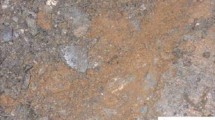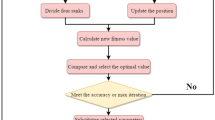Abstract
Assessment of the earthquake-induced liquefaction potential is a critical concern in design processes of construction projects. This study proposes a novel soft computing model with a hierarchical structure for evaluating earthquake-induced soil liquefaction. The new approach, named KFDA-LSSVM, combines kernel Fisher discriminant analysis (KFDA) with a least squares support vector machine (LSSVM). Based on the original data set, KFDA is used as a first-level analysis to construct an additional feature that best represents the data structure with consideration of different class labels. In the next level of analysis, based on such additional features and the original features, LSSVM generalizes a classification boundary that separates the learning space into two decision domains: “liquefaction” and “non-liquefaction.” Three data sets of liquefaction records have been used to train and verify the proposed method. The model performance is reliably assessed via a repeated sub-sampling process. Experimental results supported by the Wilcoxon signed-rank test demonstrate significant improvements of the hybrid framework over other benchmark approaches.






Similar content being viewed by others
References
Abbaszadeh Shahri A (2016) Assessment and prediction of liquefaction potential using different artificial neural network models: a case study. Geotech Geol Eng 34(3):807–815
Achen CH (2005) Two-step hierarchical estimation: beyond regression analysis. Polit Anal 13(4):447–456
Alavi AH, Gandomi AH (2012) Energy-based numerical models for assessment of soil liquefaction. Geosci Front 3(4):541–555
Ares J, Lara JA, Lizcano D, Suárez S (2016) A soft computing framework for classifying time series based on fuzzy sets of events. Inf Sci 330:125–144
Balabin RM, Lomakina EI (2011) Support vector machine regression (LS-SVM)-an alternative to artificial neural networks (ANNs) for the analysis of quantum chemistry data? Phys Chem Chem Phys 13(24):11710–11718
Battiti R (1994) Using mutual information for selecting features in supervised neural net learning. IEEE Trans Neural Netw 5(4):537–550
Baziar MH, Jafarian Y, Shahnazari H, Movahed V, Amin Tutunchian M (2011) Prediction of strain energy-based liquefaction resistance of sand–silt mixtures: an evolutionary approach. Comput Geosci 37(11):1883–1893
Cabalar AF, Cevik A, Gokceoglu C (2012) Some applications of adaptive neuro-fuzzy inference system (ANFIS) in geotechnical engineering. Comput Geotech 40:14–33
Cheng M-Y, Hoang N-D (2015) Typhoon-induced slope collapse assessment using a novel bee colony optimized support vector classifier. Nat Hazards 78(3):1961–1978
Cheng M-Y, Hoang N-D, Limanto L, Wu Y-W (2014) A novel hybrid intelligent approach for contractor default status prediction. Knowl Based Syst 71:314–321
Chou J-S, Tsai C-F (2012) Concrete compressive strength analysis using a combined classification and regression technique. Autom Constr 24:52–60
Daftari A (2015) New approach in prediction of soil liquefaction. Doctor dissertation, Freiberg University of Mining and Technology
De Brabanter K, Karsmakers P, Ojeda F, Alzate C, De Brabanter J, Pelckmans K, De Moor B, Vandewalle J, Suykens JAK (2010) LS-SVMlab toolbox user’s guide version 1.8. Internal Report 10-146, ESAT-SISTA, K.U.Leuven (Leuven, Belgium)
Dong S, Wang Z, Zeng L (2016) Lithology identification using kernel Fisher discriminant analysis with well logs. J Pet Sci Eng 143:95–102
Duda RO, Hart PE, Stock DG (2001) Pattern classification, 2nd edn. Wiley, Hoboken
Erzin Y, Ecemis N (2015) The use of neural networks for CPT-based liquefaction screening. Bull Eng Geol Environ 74(1):103–116
Farrokhzad F, Choobbasti AJ, Barari A (2012) Liquefaction microzonation of Babol city using artificial neural network. J King Saud Univ Sci 24(1):89–100
Franc V, Hlavc V (2004) Statistical pattern recognition toolbox for matlab. Research reports of CMP, Czech Technical University in Prague
Gestel TV, Suykens JAK, Baesens B, Viaene S, Vanthienen J, Dedene G, Moor BD, Vandewalle J (2004) Benchmarking least squares support vector machine classifiers. Mach Learn 54:5–32
Goh A (1994) Seismic liquefaction potential assessed by neural networks. J Geotech Eng ASCE 120(9):1467–1480
Goh A (1996) Neural-network modeling of CPT seismic liquefaction data. J Geotech Eng ASCE 122(1):70–73
Goh ATC, Goh SH (2007) Support vector machines: their use in geotechnical engineering as illustrated using seismic liquefaction data. Comput Geotech 34(5):410–421
Goh ATC, Zhang WG (2014) An improvement to MLR model for predicting liquefaction-induced lateral spread using multivariate adaptive regression splines. Eng Geol 170:1–10
Hanna AM, Ural D, Saygili G (2007) Neural network model for liquefaction potential in soil deposits using Turkey and Taiwan earthquake data. Soil Dyn Earthq Eng 27(6):521–540
Hoang N-D, Tien Bui D, Liao K-W (2016) Groutability estimation of grouting processes with cement grouts using differential flower pollination optimized support vector machine. Appl Soft Comput 45:173–186
Hu J-L, Tang X-W, Qiu J-N (2015) A Bayesian network approach for predicting seismic liquefaction based on interpretive structural modeling. Georisk Assess Manag Risk Eng Syst Geohazards 9(3):200–217
Huang G-B (2016) Basic ELM algorithms. http://www.ntu.edu.sg/home/egbhuang/elm_codes.html. Accessed 1 Feb 2016
Huang G-B, Zhu Q-Y, Siew C-K (2006) Extreme learning machine: theory and applications. Neurocomputing 70(1–3):489–501
Juang CH, Chen CJ (2000) A rational method for development of limit state for liquefaction evaluation based on shear wave velocity measurements. Int J Numer Anal Methods Geomech 24:1–27
Kang F, Li JJ, Zhou H (2013) Artificial neural network model for evaluating gravelly soils liquefaction using shear wave velocity. In: Proc. of Sixth China-Japan-US Trilateral Symposium on Lifeline Earthquake Engineering, Chengdu, China, May 28–June 1, pp 608–615. doi.10.1061/9780784413234.078
Kwak N, Choi C-H (2002) Input feature selection by mutual information based on Parzen window. IEEE Trans Pattern Anal Mach Intell 24(12):1667–1671
Lary DJ, Alavi AH, Gandomi AH, Walker AL (2016) Machine learning in geosciences and remote sensing. Geosci Front 7(1):3–10
López V, Fernández A, García S, Palade V, Herrera F (2013) An insight into classification with imbalanced data: empirical results and current trends on using data intrinsic characteristics. Inf Sci 250:113–141
Mathworks (2015) Statistics and machine learning toolbox. The MathWorks, Inc, Massachusetts, United States
McRae GJ, Tilden JW, Seinfeld JH (1982) Global sensitivity analysis—a computational implementation of the Fourier amplitude sensitivity test (FAST). Comput Chem Eng 6(1):15–25
Mika S, Rätsch G, Weston J, Schölkopf B, Müller K (1999) Fisher discriminant analysis with kernels. In: Proc. of the 1999 IEEE Neural Networks for Signal Processing, Madison, WI, 23–25 Aug 1999, pp 41–48
Min H-K, Hou Y, Park S, Song I (2016) A computationally efficient scheme for feature extraction with kernel discriminant analysis. Pattern Recognit 50:45–55
Mittal A, Devi G, Chauhan PKS (2014) Application of ANN to predict liquefaction potential of soil deposits for Chandigarh region, India. In: Pant M, Deep K, Nagar A, Bansal CJ (eds) Proceedings of the Third International Conference on Soft Computing for Problem Solving: SocProS 2013, vol. 1, Springer India, New Delhi, pp 441–450
Morgenroth J, Almond P, Scharenbroch BC, Wilson TM, Sharp-Heward S (2014) Soil profile inversion in earthquake-induced liquefaction-affected soils and the potential effects on urban trees. Geoderma 213:155–162
Muller K, Mika S, Ratsch G, Tsuda K, Scholkopf B (2001) An introduction to kernel-based learning algorithms. IEEE Trans Neural Netw 12(2):181–201
Pal M (2006) Support vector machines-based modelling of seismic liquefaction potential. Int J Numer Anal Methods Geomech 30(10):983–996
Peng H, Fulmi L, Ding C (2005) Feature selection based on mutual information criteria of max-dependency, max-relevance, and min-redundancy. IEEE Trans Pattern Anal Mach Intell 27(8):1226–1238
Pianosi F, Sarrazin F, Wagener T (2015) A matlab toolbox for global sensitivity analysis. Environ Model Softw 70:80–85
Piotrowski AP (2014) Differential evolution algorithms applied to neural network training suffer from stagnation. Appl Soft Comput 21:382–406
Rezania M, Faramarzi A, Javadi AA (2011) An evolutionary based approach for assessment of earthquake-induced soil liquefaction and lateral displacement. Eng Appl Artif Intel 24(1):142–153
Rousu J, Saunders C, Szedmak S (2005) Learning hierarchical multi-category text classification models. In: Proc. of the 22nd International Conference on Machine Learning (ICML ‘05), Bonn, Germany, 07–11 Aug 2005, pp 744–751
Samui P (2011) Least square support vector machine and relevance vector machine for evaluating seismic liquefaction potential using SPT. Nat Hazards 59(2):811–822
Samui P, Karthikeyan J (2013) Determination of liquefaction susceptibility of soil: a least square support vector machine approach. Int J Numer Anal Methods Geomech 37(9):1154–1161
Samui P, Jagan J, Hariharan R (2016) An alternative method for determination of liquefaction susceptibility of soil. Geotech Geol Eng 34(2):735–738
Seed HB, Idriss IM (1971) Simplified procedure for evaluating soil liquefaction potential. J Soil Mech Found ASCE 97(9):1249–1273
Seo M-W, Olson SM, Sun C-G, Oh M-H (2012) Evaluation of liquefaction potential index along western coast of South Korea using SPT and CPT. Mar Georesour Geotech 30(3):234–260
Shahangian B, Pourghassem H (2016) Automatic brain hemorrhage segmentation and classification algorithm based on weighted grayscale histogram feature in a hierarchical classification structure. Biocybern Biomed Eng 36(1):217–232
Shahnazari H, Tutunchian M, Mashayekhi M, Amini A (2012) Application of soft computing for prediction of pavement condition index. J Transp Eng ASCE 138(12):1495–1506
Shawe-Taylor J, Cristianini N (2004) Kernel methods for pattern analysis. Cambridge University Press, Cambridge
Sivanandam SN, Sumathi S, Deepa SN (2007) Introduction to fuzzy logic using matlab. Springer-Verlag, Berlin Heidelberg
Sladen JA, D’Hollander RD, Krahn J (1985) The liquefaction of sands, a collapse surface approach. Can Geotech J 22(4):564–578
Suykens JAK, Vandewalle J (1999) Least squares support vector machine classifiers. Neural Process Lett 9(3):293–300
Suykens J, Gestel JV, Brabanter JD, Moor BD, Vandewalle J (2002) Least square support vector machines. World Scientific Publishing Co. Pte. Ltd., Singapore
Tien Bui D, Pham BT, Nguyen QP, Hoang N-D (2016a) Spatial prediction of rainfall-induced shallow landslides using hybrid integration approach of least-squares support vector machines and differential evolution optimization: a case study in Central Vietnam. Int J Digit Earth. doi:10.1080/17538947.2016.1169561
Tien Bui D, Tuan TA, Hoang N-D, Thanh NQ, Nguyen DB, Van Liem N, Pradhan B (2016b) Spatial prediction of rainfall-induced landslides for the Lao Cai area (Vietnam) using a hybrid intelligent approach of least squares support vector machines inference model and artificial bee colony optimization. Landslides. doi:10.1007/s10346-016-0711-9
Tran T-H, Hoang N-D (2016) Predicting colonization growth of algae on mortar surface with artificial neural network. J Comput Civil Eng. doi10.1061/(ASCE)CP.1943-5487.0000599
Venkatesh K, Kumar V, Tiwari RP (2013) Appraisal of liquefaction potential using neural network and neuro fuzzy approach. Appl Artif Intell 27(8):700–720
Xue X, Yang X (2013) Application of the adaptive neuro-fuzzy inference system for prediction of soil liquefaction. Nat Hazards 67(2):901–917
Xue X, Yang X (2016) Seismic liquefaction potential assessed by support vector machines approaches. Bull Eng Geol Environ 75(1):153–162
Yazdi JS, Kalantary F, Yazdi HS (2013) Investigation on the effect of data imbalance on prediction of liquefaction. Int J Geomech 13(4):463–466
Youd TL, Idriss IM, Andrus RD, Arango I, Castro G, Christian JT, Dobry R, Finn WDL, Leslie F, Harder J, Hynes ME, Ishihara K, Koester JP, Liao SSC, Marcuson WFI, Martin GR, Mitchell JK, Moriwaki Y, Power MS, Robertson PK, Seed RB, Stokoe KHI (2001) Liquefaction resistance of soils: summary report from the 1996 NCEER and 1998 NCEER/NSF workshops on evaluation of liquefaction resistance of soils. J Geotech Geoenviron 127(10):817–833
Zhang W, Goh ATC (2016) Evaluating seismic liquefaction potential using multivariate adaptive regression splines and logistic regression. Geomech Eng 10(3):269–280
Zhang W, Goh ATC, Zhang Y, Chen Y, Xiao Y (2015) Assessment of soil liquefaction based on capacity energy concept and multivariate adaptive regression splines. Eng Geol 188:29–37
Zhao H-B, Ru Z-L, Yin S (2007) Updated support vector machine for seismic liquefaction evaluation based on the penetration tests. Mar Georesour Geotech 25(3–4):209–220
Author information
Authors and Affiliations
Corresponding author
Rights and permissions
About this article
Cite this article
Hoang, ND., Bui, D.T. Predicting earthquake-induced soil liquefaction based on a hybridization of kernel Fisher discriminant analysis and a least squares support vector machine: a multi-dataset study. Bull Eng Geol Environ 77, 191–204 (2018). https://doi.org/10.1007/s10064-016-0924-0
Received:
Accepted:
Published:
Issue Date:
DOI: https://doi.org/10.1007/s10064-016-0924-0




